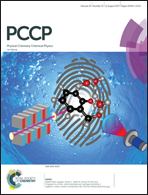Computational prediction of high methane storage capacity in V-MOF-74†
Abstract
The methane adsorption properties in M-MOF-74 (M = Mg, Ti, V, Cr, Mn, Co, Ni, Cu, and Zn) were investigated for potential adsorbed natural gas (ANG) vehicle applications. In particular, density functional theory (DFT) simulations were conducted to derive the force field parameters that were used in the grand canonical Monte Carlo (GCMC) simulations to obtain the methane adsorption isotherm curves. Our results indicate that commonly used DFT exchange correlation functionals (e.g. vdW-DF, vdW-DF2, PBE+D2) overestimated the methane binding strength to the metal sites, leading to inaccurate description of the adsorption properties. As such, the global scaling factor within the exchange correlation functional, PBE+D2, was optimized to find a suitable functional that leads to good agreement with the available experimental methane adsorption data. From the newly derived force field parameters, our computational simulations predict a methane uptake of 279 cm3 cm−3 in V-MOF-74 at T = 298 K and P = 65 bar (condition relevant to ANG storage operation), which would be higher than the current record holder of HKUST-1 (270 cm3 cm−3). Although the methane working capacity (65–5.8 bar uptake difference) is low due to strong binding of methane with the V-MOF-74, varying the process conditions (e.g. lower adsorption temperature, higher desorption temperature, lower desorption pressure) can lead to a significantly high methane working capacity, towards the goal of meeting the DOE requirements for ANG technology.



 Please wait while we load your content...
Please wait while we load your content...